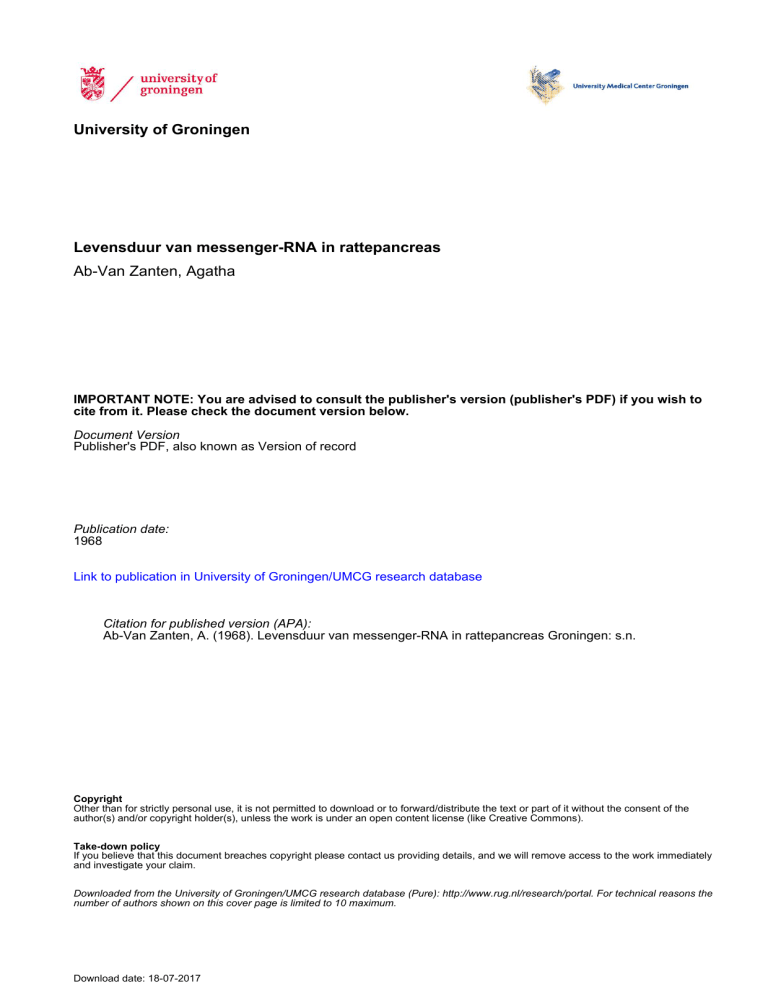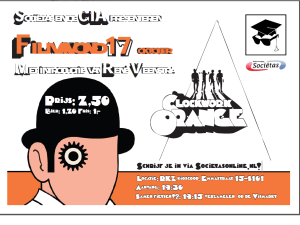
University of Groningen
Levensduur van messenger-RNA in rattepancreas
Ab-Van Zanten, Agatha
IMPORTANT NOTE: You are advised to consult the publisher's version (publisher's PDF) if you wish to
cite from it. Please check the document version below.
Document Version
Publisher's PDF, also known as Version of record
Publication date:
1968
Link to publication in University of Groningen/UMCG research database
Citation for published version (APA):
Ab-Van Zanten, A. (1968). Levensduur van messenger-RNA in rattepancreas Groningen: s.n.
Copyright
Other than for strictly personal use, it is not permitted to download or to forward/distribute the text or part of it without the consent of the
author(s) and/or copyright holder(s), unless the work is under an open content license (like Creative Commons).
Take-down policy
If you believe that this document breaches copyright please contact us providing details, and we will remove access to the work immediately
and investigate your claim.
Downloaded from the University of Groningen/UMCG research database (Pure): http://www.rug.nl/research/portal. For technical reasons the
number of authors shown on this cover page is limited to 10 maximum.
Download date: 18-07-2017
INLEIDING
De synthese van enzymen verloopt in alle organismen ge­
reguleerd, doordat laagmoleculaire verbindingen specifiek
- als effectoren - de synthese van bepaalde enzymen kunnen
versnellen ofvertragen. Over de regulering der eiwitsynthese
in bacterien is al vrij veel bekend; over die in dieren, bij­
voorbeeld gewervelde dieren, aanzienlijk minder .
Zoals later zal worden uiteengezet, kan regulering van de
synthese van spec ifieke enzyrnen plaatshebben zowel bij de
synthese van messenger-RNA (mRNA) als bij het gebruik
ervan bij de enzymsynthese zelf. Voor een inzicht in de
regulering is derhalve kennis van de levensduur van hun
mRNA essentieel.
Bij bacterien was men er reeds in geslaagd deze te be­
palen 1 ; daarb ij waren zeer korte halfwaardetijden gevonden.
Over de levensduur van mRNA in dierlijke systemen van
gespecialiseerde cellen was bij het begin van dit onderzoek
weinig bekend. Da arom werd besloten de levensduur van de
mRNA van enkele pancreasenzymen te onderzoeken.
D aar de hoeveelheid van deze mRNA niet direct bepaald
kan worden, werd d it indirect gedaan door de synthese van de be­
trokken enzymen te bepa len na stopzetting van de RNA- syn­
these met het antibioticum ac tinomycine D. In principe kan
uit het verloop van de snelheid van de enzymsynthese na
toediening van actinomycine D de halfwaard e tijd van de mRNA
voor het betrokken enzym worden bepaald.
In hoofdstuk I wordt een overzicht gegeven van enzymre ­
guleringen in het algemeen. In hoofdstuk II voIgt een uiteen­
ze tting van de overwegingen die tot de keuze van de ratte­
pancreas als studieobject hebben geleid en een overzicht
van hetgeen reeds bekend is over de regulering van de syn­
these der pancreasenzymen . Vervolgens wordt in hoofdstuk
III dieper ingegaan op methoden ter bepaling van d :.; levens­
duur van mRNA en worden overwegingen gegeven betreffende
het toepassen van actinomycine D bij ons onderzoek. De
la a tste twee hoofdstukken tenslotte beschrijven de gebruikte
methoden e n de resultaten van het eigen ondel'zoek, waari n
de invloed van actinomycine D op de RNA-synth e se in vivo en
de eiwit - en enzymsynthese in vitro werd nagegaan. Ret
laatste hoofdstuk bevat tevens een discussie van de verkre­
gen resultaten .
7
SUMMARY
In the exocrine pancreas few types of enzym," proteins are
produced and secreted in great amounts. The relative amount
of each of these enzymes is diet-dependent. The synthesis
of these proteins is therefore apparently subjected to regul­
atory control.
As this control might operate at the level of messenger
RNA synthesis, I investigated the life-time of messenger
RNA I S for chymotrypsinogen, trypsinogen, amylase and
ribonuclease. For this purpose, RNA synthesis was blocked
by actinomycin D treatment in vivo and the synthesis of
these proteins was measured in tissue pieces in vitro at
different tim,"s after cessation of RNA synthesis.
RNA synthesis was measured by determining the degree
of incorporation of labelled phosphate into total pancreatic
RNA and by comparing its value with the degree of incorp­
oration into the nucleotide pool. This was necessary as
we found that the incorporation into the nucleotide pool,
which normally shows some variability, may be drastically
lowered by actinomycin D and then shows widely diverging
values in different experiments. By comparing the two
measurements we could avoid a wrong interpretation of
lowered labelling of RNA.
As rat pancreas contains large amounts of ribonuclease,
a special isolation procedure had to be found in order to
obtaLI1 intact RNA. The following method gave good results:
Pancreas tissue was frozen in liquid nitrogen and lyophilized.
The dry powder was treated with hot phenol in the presence
of sodium dodecylsulphate and bentonite -to inhibit ribonuclease
action - and saline was added to extract the RNA. Undegraded
RNA was obtained in good yield in this way.
In the nucleotide pool, the radioactivity of the a-phosphate
(next to ribose) was determined by hydrolyzing the pyro­
phosphate linkages in saturated Ca(OH)2' Charcoal adsorption
separated the nucleotides from other com[Jonents and specific
activity of the a-phosphate was determined after combustion
of the charcoal-adsorbed mixture.
Different doses of actinomycin D were tried in order to
obtain full inhibition of RNA synthesis, while at the same
time the anim"ls should survive the treatment. A dose of
1 mg per kg rat, injected intraperiton e ally every six hours,
appeared to lead to maximal inhibition of R:NA synthesis. By
sucrose gradient analysis we could show that the l'esidual
incorporation is not due to RNA synthesis but is cau se d by
77
exchange reactions in the endgroup of transfer RNA.
The enzyme synthesis measured in vitro was shown by
several criteria to be true protein synthesis : amino acids
were indispensable and the amount of total protein increased
on incubation. Up to 18 hours after complete inhibition of
RNA synthesis, synthesis of chymotrypsinogen, trypsinogen,
amylase and ribonuclease was normal in spite of the bad
condition of the animals. The half-life of the messenger
RNA's for these enzymes is therefore certainly more than
18 hours.
When RNA synthesis had been blocked for more than 18
hours enzyme synthesis decreased. Whether this decrease
was due to partial exhaustion of the messenger RNA's could
not be decided in view of the extremely bad condition of the
animals and the known side-effects of actinomycin D.
Therefore we may only conclude that the messenger RNA
of most of the digestive enzymes from rat pancreas have a
half-life exceeding 18 hours. It is impossible by present
methods to determine this value more accurately, but it is
quite clear that in this specialized tissue messenger half­
life for some export- e nzymes is long and constitutes an
e xample of the stability of messenger RNA in specialized
cells.
78
1. C. Levinthal, A
ScLU.S., 48,
2. J. Monod, J. P.
306 (1963).
3. J. Monod, J. 'Ny
88 (19 65 ).
4. A.Ramaiah, J.A
239, 3619 (196 .
5. E. R. Stadtman
ed. F. F. Nord ,
19 66, p.41.
6. H.S.Kingdon, B
Acad. Sci. U. S. ,
7. E. W. Sutherlane
Recent progres
Press, New Yc
8. K. Marushige en
9. J. Bonner en J.
1379 (19 67).
10. S.L.Commerfo
56, 17 5 9 (1 96 6
11. G. R. Chalkleye ;
54, 498 (1965).
12. F.Jacob en J. l
13. R.A. McDonald,
14. J. Brachet, M. I
Biophys. Acta,
15. L. D. Smith en
1 6 . N.K. WessellsE
17. F.H.Wilt, J.M
18. G.Astaldi, Ciba
London, 19 60,
19. J. A. Stewart eJ
Sci. U. S., 58,
20. S. H. Wilson en
(19 67).
21. S. H. Wilson, H
103, 567 (1967
22. H.C.Pitot,
C
Proc. Natl. Aca
23. M. D. Yudkin, 1
24. D. P. Fan, J. M
25. J. D. Friese n,











